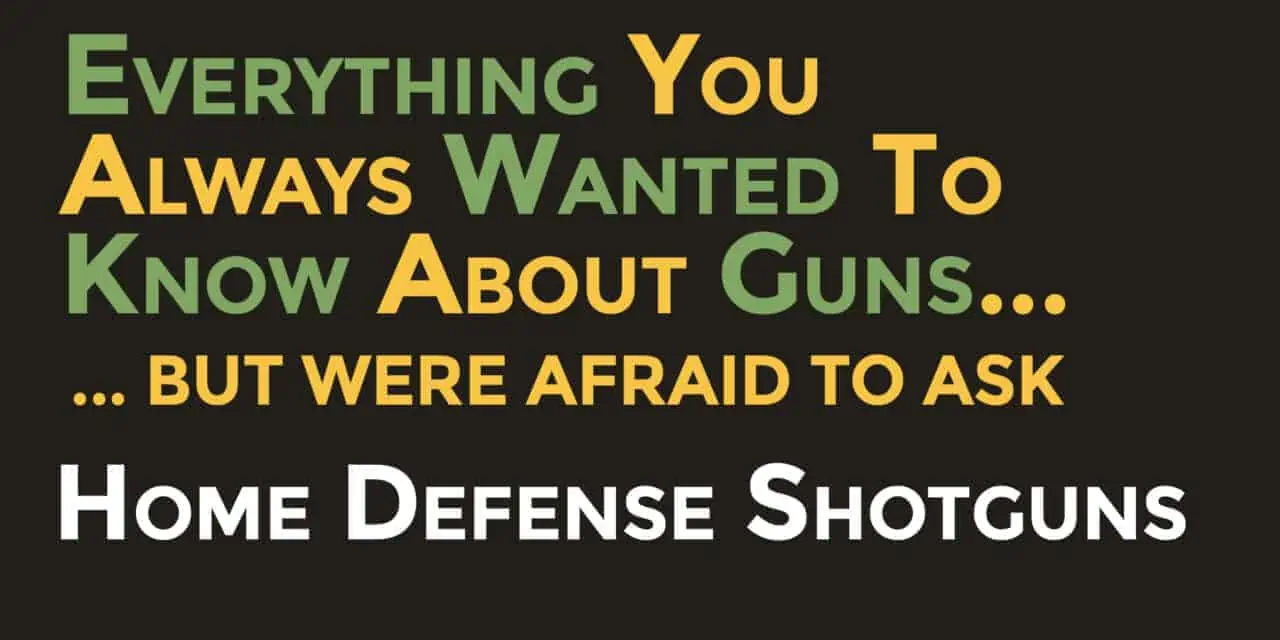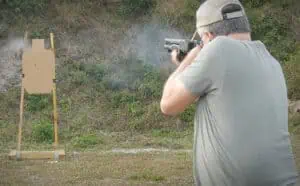Safe At Home: Choosing The Best Tactical Shotgun
The history of the shotgun goes back as far as the history of firearms themselves. The first man-portable firearms were hand cannons. These were nothing more than metal pots filled with gunpowder, stones and other random bits and pieces. The gunpowder was set off by a smoldering match, and hopefully, one of those bits and pieces ran into the target on its journey through the air. The hand cannon, or handgonne as it was also called, soon evolved into the muzzle-loading blunderbuss, which had longer barrels and wooden stocks for more accuracy.
The long reload time of a muzzle-loading gun limited the usefulness of a short-range weapon like the blunderbuss and other early scatter guns. It takes time to pour powder and shot down the barrel and reset your firing mechanism. During that time, your enemy is rushing towards you, and you’re holding a non-working firearm. Not a good place to be. As such, shotguns were primarily thought of as hunting firearms for the first few centuries of their existence.
The Shotgun Matures
When the brass shotgun shell came along in the mid 1800’s, though, things changed. A shotgun shell holds the primer, powder and shot together as one unit, allowing the user to reload very quickly. All of a sudden, the shotgun could be reloaded quickly and easily. The power of many pellets of shot hitting the target all at once was very attractive to people such as stagecoach guards, and the phrase “riding shotgun” entered our vocabulary.
The use of shotgun as a fighting tool evolved as gun technology evolved. The pump-action Winchester 1897 was the best tactical shotgun of its day and gained a reputation as a “trench broom” in World War 1. The shotgun went semi-automatic with the introduction of the Browning Auto 5, a gun that lives on to this day (in modified form) as the Browning A5. Pump action guns and semi-automatic shotguns are now in common use by both the military and law enforcement. The devastating effects of a full-power shotshell make them an extremely effective close-range fighting tool. This firepower also makes them a popular choice as a home defense gun, and that’s the context we’re going to use to choose the best tactical shotgun (or shotguns) available today.
Ammunition Is The Foundation
Let’s begin by talking caliber, or gauge, as it’s called in the world of shotguns. 12 gauge is the ammo choice for militaries and law enforcement agencies around the world. As such, there is an almost limitless variety of defensive ammunition for guns that shoot 12 gauge vs. guns that shoot smaller shells, such as 20 gauge. 12 gauge definitely has more recoil than smaller rounds, but with a properly set up gun, some good training and a little practice, almost anyone can effectively use a 12 gauge shotgun as a defensive gun.
A shotgun has a lot of advantages as a defensive firearm. A single round of 00 buckshot launches eight or nine .32 caliber pellets at the target at around 1200 feet per second. While each individual pellet has less energy than, say, a round of .380 ACP, all those pellets are hitting the target at one time. This creates an effect on the target that is more than just the sum of the whole. A shotgun loaded with buckshot will end fights faster than a pistol will, and deer slugs (a solid chunk of lead rather than shot pellets) will end a fight even faster.
Flexible And Powerful
That flexibility of ammunition is another nice advantage of a shotgun. You can use lower-priced birdshot rounds for practice and training, and then switch to buckshot and slugs when done. You can even shoot less-lethal rounds through a shotgun if you so chose. Finally, using a shotgun for home defense doesn’t have the stigma attached to it in today’s society like using an AR-15 does. There is nothing wrong with using an AR-15 for home defense: I have one in my safe room, right next to my shotgun. However, right now, the AR-15 or any other so-called “assault weapon” has some baggage associated with them. As gun owners, the last thing we want to hear in a courtroom is, “Your Honor, the prosecution would like to enter into evidence” or something similar. Plan accordingly.
As we said before, shotguns can also shoot slugs. These are essentially bullets, (more or less) that weigh around one ounce and are great for close-range deer hunting. They also make very good defensive rounds, but their accuracy is poor compared to a dedicated rifle. A good slug shooter can get hits on-target out to 50 yards, which is close range for most defensive rifles.
The Downside To A Tactical Shotgun
The disadvantages of a shotgun should not be overlooked. They are not all that accurate compared to the accuracy of a rifle, even when shooting slugs. There are reasons why shotguns have the nickname “scatterguns.’ With careful selection of ammo and gun, you can get all the pellets to land on-target at least out to 25 yards. Beyond that, you run the risk of a stray pellet missing the target and hitting something else downrange, with potentially disastrous results. A shotgun also has limited capacity. 3 or 5 rounds are the standard for most hunting guns, with more tactically-oriented guns holding seven or eight rounds. There are ten-round box-fed shotguns on the market (with options for even more), but the jury is out on the reliability of those guns compared to the more-common tube fed guns.
Ammo selection is very important. The best tactical shotgun in the world means very little if it’s loaded with low-power, lightweight birdshot. As a rule, as the number used to describe a shotshell increases, the weight of each pellet decreases and the more pellets are packed into a shell. Birdshot rounds such as #7 or #8 are great for training and practice, but are best put to use as hunting or target rounds, not to defend something that is near and dear to you. When it comes to stopping man-sized threats, go with #00 or #000 buckshot, and leave the birdshot for the birds.
The Best Tactical Shotgun Needs The Best Accessories
Sporting shotguns commonly have a choke at the end of their barrels. A choke is a restrictor that narrows the spread of shot from the barrel as it leaves the tube. This is important if you’re trying to knock a duck out of the sky. It’s not important on a defensive gun used at close ranges, though, which is why you’ll see that many of the best tactical shotguns have smooth bores with no chokes installed.
A good gun can be made better with the right accessories. Some of the gear that enhances the performance of a tactical shotgun include a sling for easier carry and a side saddle to hold extra ammo. You may be tempted to combine the two and use a combination sling and ammo carrier. Resist that temptation. Ammo slings may look cool and work well when hunting, but they are clumsy and slow to use when your target is shooting back at you. The standard stocks on most tactical shotguns are meant to fit a wide range of people. This means, of course, that they’re not really a good fit for any one person in particular. Adding an adjustable stock, like the ones from Airdus or Magpul, means you can fit your gun to your body, increasing your aiming speed and lowering felt recoil.
There are five guns in particular that stand out from all the other defensive shotguns on the market. They are:
The Best Tactical Shotgun Available Right Now
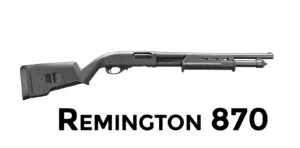 Mossberg 500/590. MSRP: $553. A legendary pump-action shotgun, and my home defense firearm of choice. The 500 and 590 are both available with a wide variety of accessories and are in use by both military and law enforcement agencies all over the world. They both have a safety mounted on the rear of the stock, making it equally usable by right or left-handed shooters.
Mossberg 500/590. MSRP: $553. A legendary pump-action shotgun, and my home defense firearm of choice. The 500 and 590 are both available with a wide variety of accessories and are in use by both military and law enforcement agencies all over the world. They both have a safety mounted on the rear of the stock, making it equally usable by right or left-handed shooters.
Remington 870. MSRP $443 and up. Another proven pump-action performer. Chances are, if there is a shotgun in a patrol car somewhere, it’s a Remington 870 of some kind. Remington has made over 11 million 870 shotguns since it was first introduced in 1950. That legacy means that 870 is trusted as both a hunting gun and as a self-defense gun, and there is no end in sight for this renowned firearm.
Semi-Automatic Options
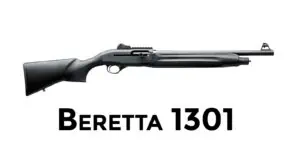 Beretta 1301. Beretta has been making shotguns since before the United States was a country, and this heritage shows in the semi-automatic 1301. The 1301 is relentlessly reliable, and the gas operation helps tame some of the recoil associated with a 12 gauge round. The popularity of the 1301 is on the rise right now, thanks in part to the work of noted firearms trainers such as Rob Haught and the team at 360 Performance Shooting.
Beretta 1301. Beretta has been making shotguns since before the United States was a country, and this heritage shows in the semi-automatic 1301. The 1301 is relentlessly reliable, and the gas operation helps tame some of the recoil associated with a 12 gauge round. The popularity of the 1301 is on the rise right now, thanks in part to the work of noted firearms trainers such as Rob Haught and the team at 360 Performance Shooting. 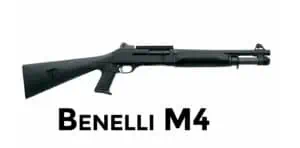
Benelli M4. MSRP: $1999 and up. Another semi-automatic shotgun, a variant of the M4 is in use right now by the U.S. military as the M1014 Joint Service Combat Shotgun. The patented gas operation of the M4 adjusts for shell size, allowing the gun to cycle low-power/reduced recoil shells as easily as it handles full-strength buckshot and slugs.
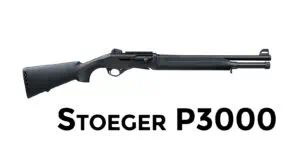 Stoeger P3000 Freedom. MSRP: $339. The P3000 is a semi-automatic shotgun made in Turkey and imported into the U.S. by Stoeger. Stoeger has a long history of making inexpensive shotguns that perform just as well (or better) than other higher-priced guns. This makes the P3000 a viable choice if money is a bit tight and you can’t afford the other guns on this list.
Stoeger P3000 Freedom. MSRP: $339. The P3000 is a semi-automatic shotgun made in Turkey and imported into the U.S. by Stoeger. Stoeger has a long history of making inexpensive shotguns that perform just as well (or better) than other higher-priced guns. This makes the P3000 a viable choice if money is a bit tight and you can’t afford the other guns on this list.
Buy It, Learn It, Keep It Safe
A tactical shotgun is a powerful defensive tool, but it does absolutely nothing by itself. Owning a gun that can stop most fights with a single shot does not excuse you from learning how to use it effectively in a defensive situation. Once you’ve chosen the best tactical shotgun for you, take it to the range and see how it performs with your ammunition of choice at different distances. You’re relying on that shotgun to save your life. Better to learn what it can (or can’t) do long before that happens.

